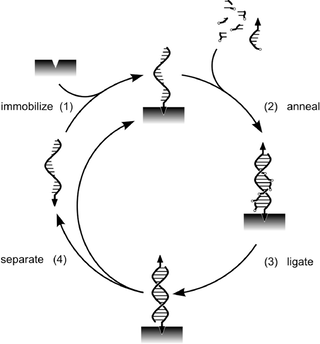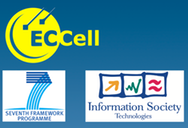Beyond SPREAD to scpDNA replication
Iterative stepwise amplification is one remedy to overcome product inhibition in molecular replication. Product inhibition prevents exponential amplification of many replicators in the observable concentration range. Whereas temperature cycling as in PCR is a good solution for enzymatic replication, it is less useful in rapidly reequilibrating
Exponential amplification was achieved by Luther et al. in a scheme the authors called SPREAD (“Surface Promoted Replication and Exponential Amplification of DNA analogues”). The principle is shown below.
 Amplification starts by letting a set of precursor fragments hybridize to an immobilized template (step (2)). Chemical ligation then joins the fragments to yield a complementary copy of the immobilized template (step (3)). On the action of a denaturating agent (e.g. sodium hydroxide, pH 12) the copy is released (step (4)) and transported to another fraction of a surface matrix which now reacts with a chemical function (arrow head) at the 5’-end of the copy (step (1)). At the end of the first half of the cycle there are two strands immobilized and both will act as templates in the subsequent steps. Immobilization is thus a means to prevent product inhibition.
Amplification starts by letting a set of precursor fragments hybridize to an immobilized template (step (2)). Chemical ligation then joins the fragments to yield a complementary copy of the immobilized template (step (3)). On the action of a denaturating agent (e.g. sodium hydroxide, pH 12) the copy is released (step (4)) and transported to another fraction of a surface matrix which now reacts with a chemical function (arrow head) at the 5’-end of the copy (step (1)). At the end of the first half of the cycle there are two strands immobilized and both will act as templates in the subsequent steps. Immobilization is thus a means to prevent product inhibition.
